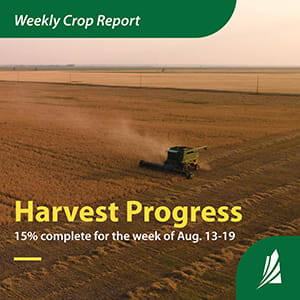Released on August 22, 2024
Producers continue to make progress with harvest despite scattered storms throughout the province over the past week. A few areas received severe storms producing heavy rain and hail causing some crop damage. The lack of moisture in other areas of the province continues to advance crop maturity. Producers that have started harvest are indicating variable yields across the province. In many regions increased heat has impacted grain fill resulting in yield reductions across various crops.
Currently, Saskatchewan is reporting 15 per cent of harvest complete, ahead of the five-year average of 13 per cent and the 10-year average of 11 per cent. The southwest continues to lead in harvest progress, with 29 per cent of the crop harvested. This is followed by the southeast at 21 per cent and the east-central region at 17 per cent. Notably much of the harvest progress for the east-central region has occurred around the Hanley area due to experiencing drier conditions as compared to the rest of the region. The west-central and northeast regions both sit at five per cent harvest completion and the northwest region reports one per cent of harvest complete.
Harvest progress advanced for all crops over the past week. Provincially, fall rye leads in harvest progress at 62 per cent followed by triticale at 61 per cent and winter wheat at 56 per cent. Lentils and field peas continue to lead the spring-seeded crops in harvest progress; 50 per cent of lentils and 44 per cent of peas are harvested. For cereals, barley sits at 17 per cent harvested, durum is 14 per cent, oats are 11 per cent and spring wheat is four per cent harvested provincially. With 17 per cent harvested, mustard leads in oilseed harvest progress followed by canola at only two per cent harvested across the province.

Provincially, grade quality is variable for fall rye and winter wheat. Fall rye is reported at 57 per cent 1 CW, 26 per cent 2 CW, and 17 per cent 3 CW. Winter wheat grade quality is reported at 61 per cent 1 CW, 25 per cent 2 CW, 13 per cent 3 CW and one per cent as feed.
Rain was variable over the past week with areas receiving no rainfall, to isolated storms reported that produced heavy rain and hail. The highest rainfall recorded fell in the Craven area at 69 mm, followed by the Strasbourg area at 66 mm and the Caron area at 52 mm. The Arborfield area received 49 mm and the Rosthern area received 48 mm over the past week.
Recent moisture has helped improve topsoil moisture conditions across some areas of the province. Currently, cropland topsoil moisture is 35 per cent adequate, 41 per cent short and 24 per cent very short. Hayland topsoil moisture is 31 per cent adequate, 44 per cent short and 25 per cent very short. Pasture topsoil moisture is 25 per cent adequate, 43 per cent short and 41 per cent very short.
Pasture conditions have declined in certain regions. Currently, four per cent of pastures are in excellent condition, 22 per cent are good, 36 per cent are fair, 25 per cent are poor and 13 per cent are very poor.
Crop damage over the past week was mainly due to the lack of moisture throughout many regions, along with the increased temperatures. Crop lodging, due to wind damage, was also reported across the province along with hail damage in isolated areas. Grasshoppers continue to persist in the drier regions of the province as well. Producers are still evaluating sclerotinia stem rot development within their fields as canola matures but many regions are reporting increased amounts of infection this year.
As producers continue with equipment maintenance, hauling bales, desiccating, swathing and harvesting over the next week, they are reminded to take safety precautions in all the work they do. This includes having fire mitigation resources at the ready and taking precautions when working around powerlines. The public is also reminded to exercise caution regarding machinery and equipment travelling on roadways. Harvest can be a stressful time for producers and the Farm Stress Line is available to provide support toll free at 1-800-667-4442.
A complete, printable version of the Crop Report is available online - Download Crop Report.
Follow the 2024 Crop Report on Twitter at @SKAgriculture.
-30-
For more information, contact: